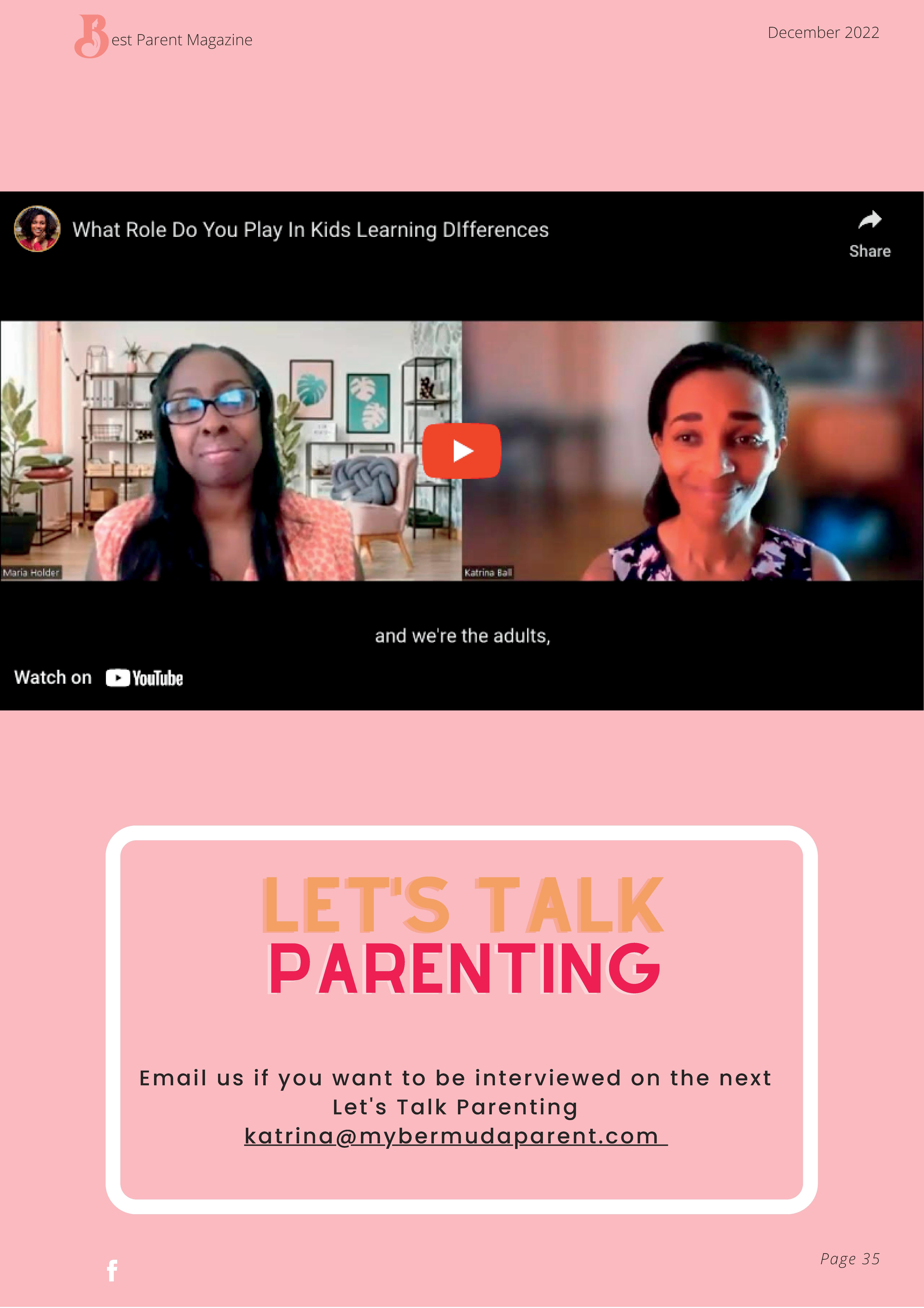GET YOUR KIDS TO DRINK

MORE WATER
AVOID PASSING ANXIETY ON TO YOUR CHILD
RAISING KIDS


MARRIAGE WITH KIDS: HOW TO KEEP YOUR RELATIONSHIP STRONG


GET YOUR KIDS TO DRINK

MORE WATER
AVOID PASSING ANXIETY ON TO YOUR CHILD


MARRIAGE WITH KIDS: HOW TO KEEP YOUR RELATIONSHIP STRONG

A BRILLIANT START WITH MSA 1 0
1 4
HOW TO AVOID PASSING ANXIETY ON TO YOUR KIDS
2 3
2 5
1 2
HOW TO GET YOUR KIDS TO DRINK MORE WATER
1 3

COMMUNICATING WITH YOUR YOUNG CHILD

1 9
TALKING MONEY WITH THE FAMILY
2 8
RAISING KIDS WHO ARE SMART ABOUT MONEY

2 0
LIGHT THE FIRE: MAXIMISING MOTIVATION TO LEARN


I am excited to share this second digital issue with you and continue to provide the topics you want to read and hear about My desire is to make Bermuda Parent as interactive as possible through the magazine and the Facebook Group. So if you aren't in there you should definitely get in there


I feel like I always say this but where has the time flown. It seemed like the start of 2022 wasn't that long ago and now in a few more sleeps we'll be in 2023,
I want to wish each one of you a great holiday as December comes in I would love to hear your thoughts and comments on any of the articles and if you want us to cover anything specific Join the conversations in the Facebook Community.
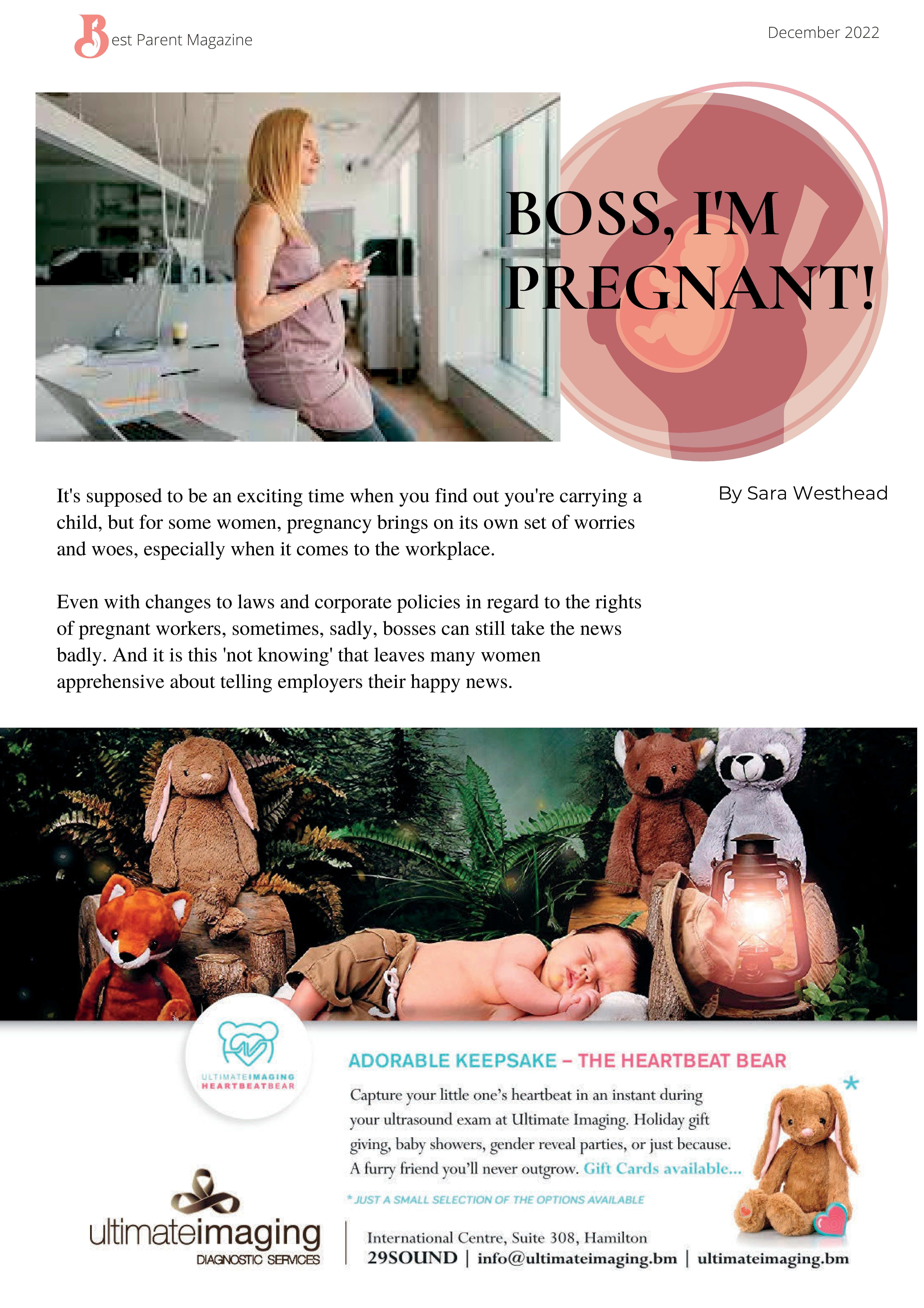
Are you experiencing early complications, like severe morning sickness, that are causing you to miss more work than you normally would? Most often, employers would rather hear the news than be left to continually wonder what is wrong, which, in turn, looks bad on your part.
Before you make the news public, it is advisable to research your company's policies in regards to maternity leave Make sure you know how much paid and unpaid leave you can take, and then determine what you personally plan on taking, particularly if you plan on returning to work.
According to the Employment Act of 2000, a woman who has worked at a company for 12 months or more, or will have worked for a company for 12 months by the expected date delivery, is entitled to eight weeks paid and up to four weeks unpaid leave.
A woman who has worked less than a year is entitled to up to eight weeks unpaid leave By law, notice for intended leave must be made at least four weeks before you expect to start your leave, although it is wise to give more notice. Also, by law, you are required to give your employer at least two weeks’ notice of your return to work; failure to do so allows your employer to assume that you do not plan to return Your employer is also required to allow you to return to your same position, or to a comparable position, with the same wages, benefits and seniority. If an employer fails to do this, you do have the right to make a complaint to the Employment Council for breach of the Employment Act, and/or unfair dismissal, even opening the possibility of sexual discrimination That said, this is the bare minimum
Some larger companies do offer more robust maternity benefits, which is why it is important to know what your particular employer's policy is.
Generally, it is perfectly acceptable to wait until the second trimester, even up to 20 weeks, before you tell your boss, though it is often advisable to tell them before you are showing more than just the beginnings of that baby bump


However, there are times when you will need to break the news sooner If you have a particularly stressful or strenuous job, the sooner you tell, the better it will be for you and your unborn baby. This is especially important if you are exposed to chemicals that can be harmful to an unborn baby
Once you are armed with your company's policies, you also need to get a letter from your doctor that includes an estimated due date, before you can even ask for your maternity leave.
While some women may simply wish to tell their boss, others may want to be fully prepared before they go in, complete with their estimated due date, their date they anticipate going on maternity leave, the date they plan on returning to work, and how much paid and unpaid leave they plan on taking, as it will alleviate any questions your boss may have straight away.
You may even be able to ask to break up the unpaid leave with the paid leave, so that you don't find yourself without a paycheck for a whole month – for example, ask if you can take two weeks unpaid, then your full paid leave, then the last two weeks unpaid.
It is important to speak with your boss first and in private, rather than telling all your co-workers first and your boss then accidentally hearing the news through the grape vine
You may want to coincide your timing with the completion of a project or another milestone, so that your boss can see that you have been keeping up with your work and succeeding, all while being pregnant



Do not be apologetic – you have nothing to be sorry for. That said, once the news is shared, it doesn't mean you can sit back and relax, either. You need to continue keeping up with your work, making arrangements to keep your tasks covered when you have pre-natal appointments or when you're feeling under the weather In fact, you may want to come up with possible solutions to these kinds of questions even before they are asked, such as telecommuting.
Finally, once you are on leave, it is important to maintain regular contact with your boss, especially if you were a part of a big project that has continued now that you are on leave. Make it clear that you are on leave, but that you will, say, answer emails once a day to answer any questions from your boss or that the person filling in for you may have.
Crying all the time. Worrying about the smallest things. Bouncing off the walls. Having trouble keeping still. And let’s not talk about the angry outbursts. Well actually, let's talk about it
Anger, excessive worrying, emotions that are all over the place, hyperactivity & difficulty concentrating are all signs your child's brain needs help.
Your child needs you to understand what’s really going on inside their beautiful brain. As a parent of three young kids, it became very clear to me that nobody is going to care for your child like you
Not the teacher; Not the Pediatrician; Not the Pastor Don't get me wrong there are lots of people who care and want to lend their support. However, as parents we spend the most time with our kids; and we experience them and know them better then they know themselves (especially in the early years)
That's why it’s up to us to recognize when our kids are struggling and when to intervene to help them to thrive. We all want the best for our kids, we all want to see our kids thriving as functional adults and contributing to our community. The problem is kids don't come with an operating manual, and we often have no clue how to take care of these little bodies. It's a wonder we get to leave the hospital with them after they are delivered
And take no offense to this, because as board-certified pediatrician you would have thought that I knew everything I needed to know about babies and children.
I didn’t! It wasn’t too much later that I found out that I was just as clueless as most parents. That's why I can easily say that my last 9 years enrolled in Parent-versity has been by trial and error.
There is hope though, my mistakes can be your gains. Which is why it want you to know these 5 tips to helping your child’s brain to thrive First, it’s important for you to know what signs to look out for that suggest your child needs more help with their brain health.
A healthy brain makes for a happy child. Signs to watch out for in your child Irritability, poor eye contact, restlessness, poor sleeper, temper tantrums, difficulty following instructions, quick to argue or fight, crying, moodiness, fearful, anxious, difficulty learning and delays in development like slow to walk, slow to talk, hearing issues, poor handwriting
If your child is experiencing any of these, let me remind you quickly that you and your child are beautiful, and their brain can improve and heal. Here are the tips I wish knew when I first took my oldest daughter home

If your baby or child is not sleeping then you need to focus on improving sleep quality for your child and your family Avoid things that interfere with sleep like night lights that emit blue light; Wi-Fi Radiation that decreases melatonin levels. Melatonin is the sleep hormone, and you need it to get good sleep. Light from screens like iPads and TV; give off blue light which also lowers melatonin levels. Also be conscious of what your child is watching; fast-moving content with lots of flashing can increase hyperactivity Kids also can have issues like Sleep Apnea that isn't necessarily related to being overweight If a child has an under-developed jaw or large tonsils, they can stop breathing for short periods while they sleep Your child’s doctor or dentist can help arrange a sleep study if you/they suspect this of your child. If you don’t know where to start consider working with a sleep coach.
It’s as simple as getting your child outside to play. And Yes, I'm a mother so I know that with the pull of TV and Screens it is getting to be easier said than done. This is where organized activities, extracurriculars and clubs come in They create great distractions, help your child’s physical health and mental health If the activity is outside such as football, running club or tennis; it's even better. Work with your child, figure out their interests. I recommend (depending on their age) they get involved in 1-3 activities.

Sounds silly but kids who experience more love and laughter in their homes thrive more Do things that will both make you smile and laugh. Play music, sing songs, make up a silly dance, play cards, build blocks or a wacky train track, share silly jokes No one will judge Laugh until your child’s face hurts or has happy tears.

We all should be pooping every day Pooping is your child's body's way of getting rid of waste and toxins Toxins can build up in the body and in your child's brain if they are not pooping. Make talking about pooping a normal thing. Encourage and praise daily bowel movements. One poop a day can really keep the doctor away. It's not normal to not poop every day; even if you are not an everyday pooper and your mother wasn't either Break the trend, add in more fruit and vegetables, consider prune juice if you have too Rubbing magnesium lotion on your child's belly, is one of my favorites

It’s as simple as getting your child outside to play And Yes, I'm a mother so I know that with the pull of TV and Screens it is getting to be easier said than done. This is where organized activities, extracurriculars and clubs come in. They create great distractions, help your child’s physical health and mental health If the activity is outside such as football, running club or tennis; it's even better Work with your child, figure out their interests I recommend (depending on their age) they get involved in 1-3 activities


Choosing the first school for your child can seem like a monumental task. After all, this is your child’s first experience with formal education and it has the power to shape his or her attitude towards school going forward.

MSA realizes the importance of getting it right from the very beginning. By taking a child-centric approach to education during these formative years, MSA fosters a lifelong love of learning.
Beginning with the Early Years Program (ELP), MSA allows children’s interests and discoveries to propel the curriculum. In response to open-ended, thoughtprovoking questions, ELP students generate their own ideas and theories. Teachers guide the students’ thinking, document their ideas and support their learning. They provide ample opportunities for play, exploration, discovery, and problem-solving.
In ELP, the students are introduced to the Reggio Emilia approach, which MSA incorporates into students’ learning until Grade 5. Reggio Emilia is an educational philosophy that views children as humans with great potential for development. This nurturing, child-centric approach encourages expression, investigation, exploration, and reflection.
In ELP, the students are introduced to the Reggio Emilia approach, which MSA incorporates into students’ learning until Grade 5. Reggio Emilia is an educational philosophy that views children as humans with great potential for development. This nurturing, child-centric approach encourages expression, investigation, exploration, and reflection.
A central tenet of the Reggio Emilia approach is “100 Languages”, which is a metaphor for the potential within children to think in a hundred different ways that are interconnected. By honoring the 100 Languages, MSA encourages students to express themselves in a myriad of ways and documents their interests, feelings, and ideas as a visual record of their learning.
ELP students are also introduced to Kagan Cooperative Learning, which is woven throughout all grade levels at MSA. Small groups of students learn to work together in the classroom, increasing their motivation and engagement.
Beyond encouraging collaboration, Kagan Cooperative Learning helps students at MSA to build a supportive learning community
Upon successfully completing ELP, students are guaranteed placement into MSA’s Kindergarten class, with class sizes ranging between 15 and 20 students.
In Kindergarten, students participate in a wide variety of organized activities and purposeful play experiences. In keeping with contemporary education research, MSA provides a developmentally appropriate environment for active learners. The students interact with their peers and are engaged in acquiring language, numeracy, and social skills.

To learn more about how ELP or Kindergarten at MSA can give your child the best start, please call 2924134 or visit msa.bm.


We all know we need to drink more water - but sometimes we forget that drinking enough water is even more important for our kids. Your child's body needs water to stay healthy, especially when they're active. When your child gets enough water, it cools down their body, aids in digestion, keeps their brain and muscles working at peak performance, and even lubricates their joints
So how can you convince your kids that good ol' H2O is better than sugar-laden sodas and sports drinks? It might be tough, but these tips may help.
How much water your child needs depends on your child's age, height, weight, and activity level Children over one year of age should drink about one ounce of water per pound of body weight each day. If you aim for at least 6-8 cups of water a day, that should be good for most children Active kids will
likely need an additional cup of water for each hour of activity, and even more as the temperature increases due to loss from sweating
Encouraging your child to drink more water doesn't have to be difficult The best way to help your kids drink more water is to keep it accessible and fun! These tips may help:


Be an example. One of the most effective teaching tools you have is to be a good example Fill up your water bottle and let your kids see you drinking from it throughout the day

Add ice This encourages children to drink more Also try adding berries, citrus fruits, or even slices of cucumber to the water for a little flavor without a lot of sugar.
Let your child pick out a special drinking cup or water bottle to use at home and onthe-go
Make water the beverage of choice, on-the-go or even if you're eating out
Don't buy sugar-sweetened beverages or sports drinks. Your kids can't drink them if you don't buy them.
Teach young kids how to fill up their own cup or water bottle Independence is a powerful tool!
Let kids use fun straws to encourage them to drink more water
Buy small water bottles that are easier for kids to drink out of.
Set up a reward system for the whole family. Encourage them to drink a certain amount of water daily Reward everyone with a fun activity when you all reach the goal
Getting your kids to drink more water doesn't have to be difficult. Remember to keep it accessible and fun, then you'll have success in increasing the amount of water your kids drink.

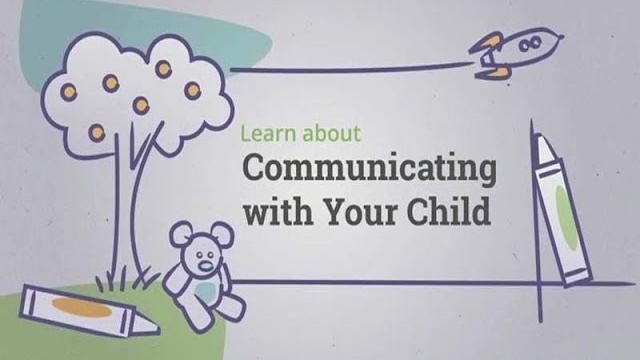


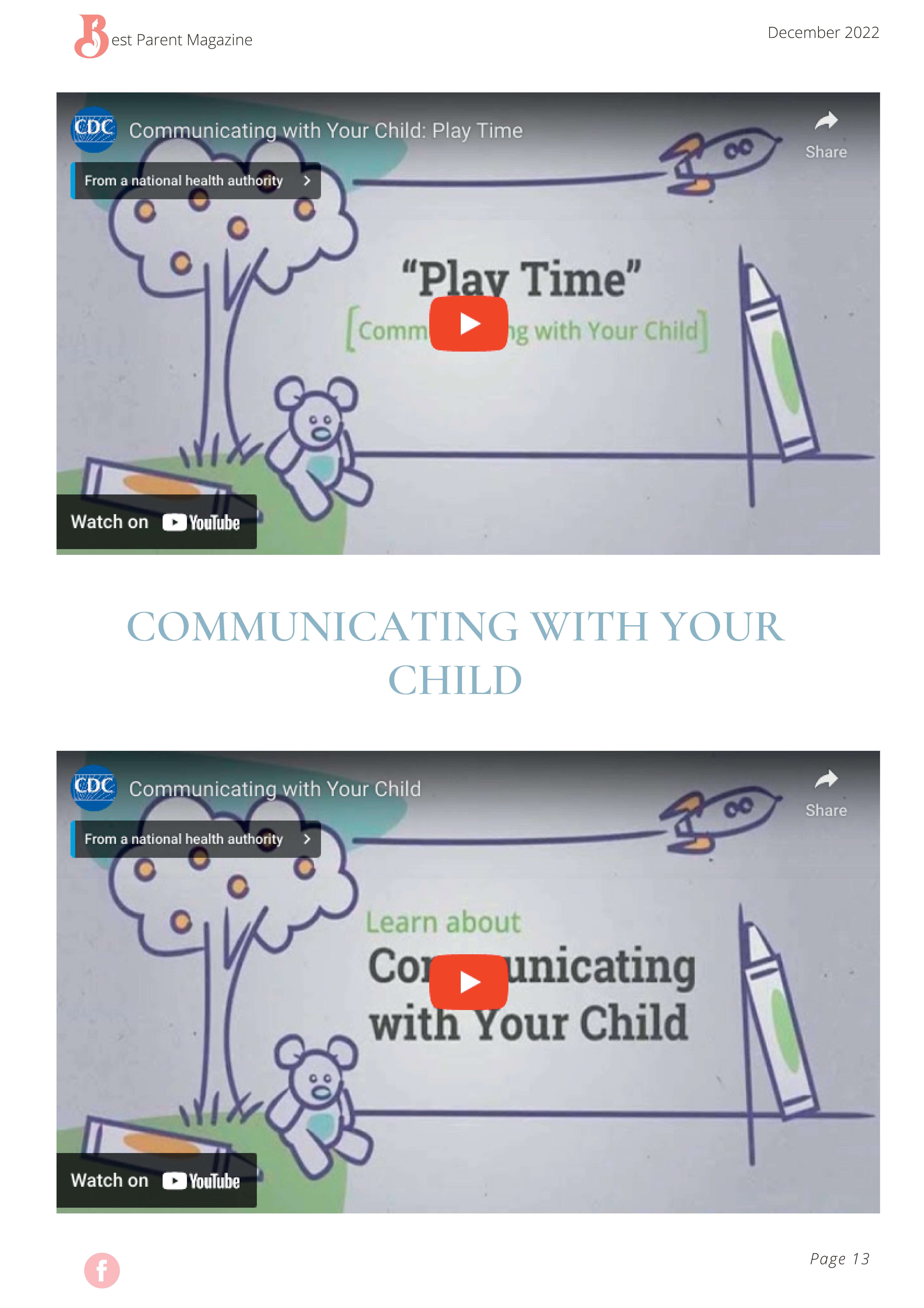 From a national health authority
Communicating with Your Child: Play
From a national health authority
Communicating with Your Child
From a national health authority
Communicating with Your Child: Play
From a national health authority
Communicating with Your Child

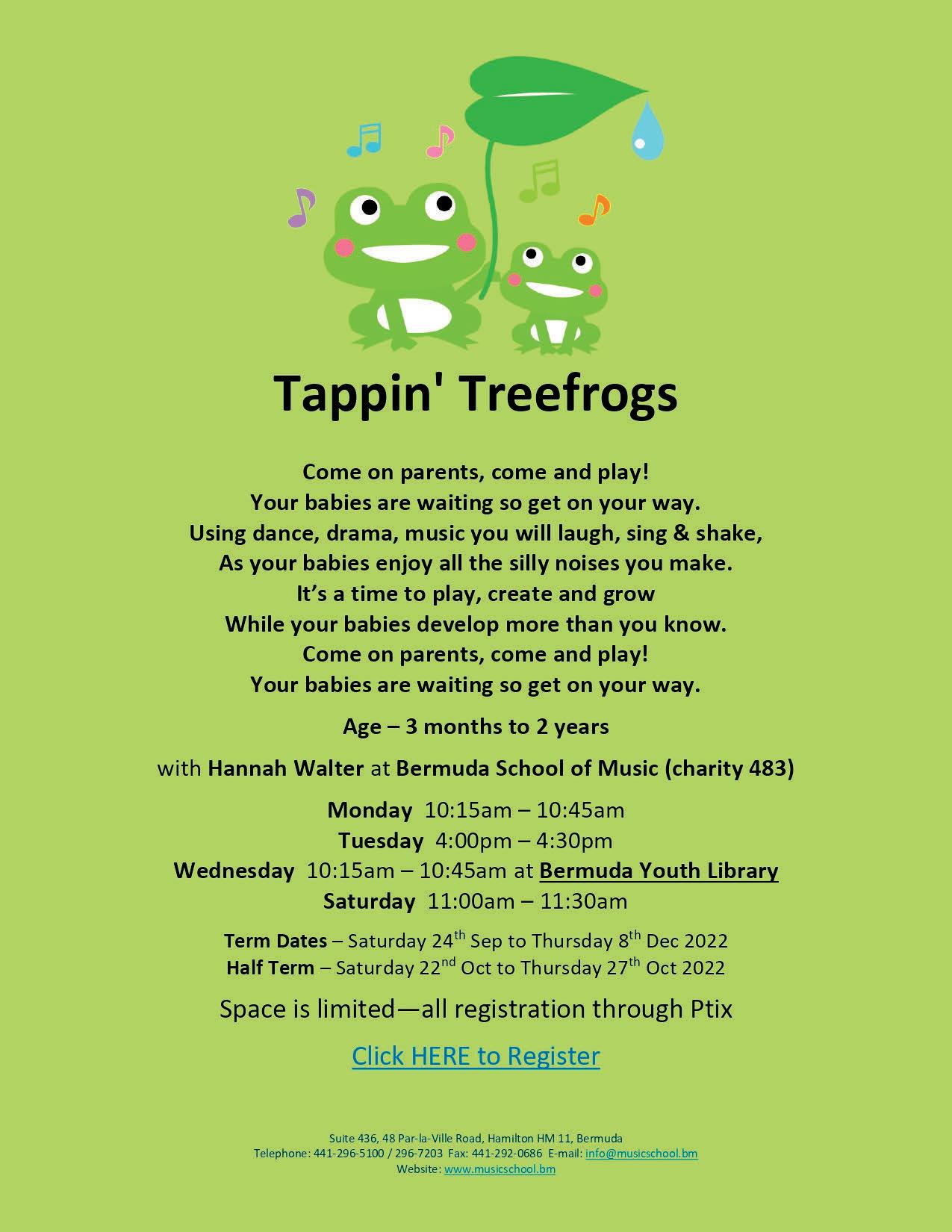


Managing your own stress is the best way to keep your child from picking up your anxiety. You can try mindfulness techniques like deep breathing. Practicing mindfulness every day can help you feel calmer in general and make the techniques more effective when you are feeling anxious. You can also try to identify the things that make you anxious and set boundaries or come up with a plan for how to respond to them. Working with a therapist can help.


Once you know how to manage your own stress, you can help kids learn those same skills. You don’t need to hide your anxiety. Instead, talk to kids about what you feel and how you cope with it. You might say:


“I’m feeling scared right now, but I know it’s not that likely that the thing I’m scared of will actually happen.” cont'd nexyt page.
Read Full Article here


If you do something you regret later, talk about that too: “I yelled at you this morning because I was anxious we would be late. But I know there are better ways to react when I feel that way.” Talking about anxiety sends kids the message that stress is normal and they can manage it. It can also help to plan for dealing with anxiety before it happens. Talk to kids about how you can work together to make life less stressful. For example, maybe they get points toward a


little reward every time they get ready for school on time. But try to avoid putting kids in charge of managing your anxiety. If a certain thing causes you a lot of stress, find other adults to take over or give you support. Parenting while taking care of your own mental health is hard, but you don’t have to do it alone.



Anxiety is the most common emotional problem in children. Kids can develop crippling about many things from animals to being separated from their parents to saying or doing something embarrassing.
Anxiety can show up in lots of different ways, including headaches, stomaches, extreme shyness, and tantrums.



Cha-Ching - Earn, Save, Spend and Donate






O W N E H O U S E
One trademark of a great teacher is a love of their subject. Enthusiasm is an important means of motivating pupils since it is infectious However, enthusiasm alone is not enough: a nuanced approach to classroom management is also needed to engage all pupils effectively.
At a busy school it can be hard to find the time to share best practice – so it is necessary to ensure that time is set aside for this purpose
Downe House teachers share some of the strategies they adopt to sustain high levels of motivation in their lessons
Set high expectations: Our pupils respond well when their teachers set high standards in terms of classroom routines and completion of work They thrive in a secure learning environment in which they know their work will be checked fairly and rigorously
Set high expectations: Our pupils respond well when their teachers set high standards in terms of classroom routines and completion of work They thrive in a secure learning environment in which they know their work will be checked fairly and rigorously

Let them know you care! Effort levels peak when pupils know their teacher really cares about them But –be warned! – caring is not necessarily fluffy As Ms Thabet, Teacher of Mathematics, says: “When I care about you…poor you!” This is because she is relentless! She always follows things up and is uncompromising with her rules and standards: “That’s my ‘brand’ of caring, and my pupils recognise it ”
Develop a good rapport: Everyone appreciates being noticed and appreciated. A simple “How was your weekend?” from the teacher, or noting an achievement in an extra-curricular activity, can be very affirming and motivating for any pupil

Set high expectations: Our pupils respond well when their teachers set high standards in terms of classroom routines and completion of work. They thrive in a secure learning environment in which they know their work will be checked fairly and rigorously.
Let them know you care! Effort levels peak when pupils know their teacher really cares about them But – be warned! – caring is not necessarily fluffy. As Ms Thabet, Teacher of Mathematics, says: “When I care about you… poor you!” This is because she is relentless! She always follows things up and is uncompromising with her rules and standards: “That’s my ‘brand’ of caring, and my pupils recognise it ”
Develop a good rapport: Everyone appreciates being noticed and appreciated A simple “How was your weekend?” from the teacher, or noting an achievement in an extra-curricular activity, can be very affirming and motivating for any pupil.


Be invested in your feedback: Pupils need to feel that their teachers are invested in them Individually tailored and detailed verbal praise or constructive criticism can convey this, as can prompt feedback about a task (always appreciated!)
Make it real: Pupils often engage best with a topic if they can relate it to the real world In politics, for example, it can be very powerful when pupils bring their ideas and reactions to current events into classroom discussions. Similarly, sharing aspects of Italian culture can hook them into learning related vocabulary and grammar more effectively As Dr Hosker, Teacher of Italian, advises: “Know your pupils and tap into their preferences.”
Give pace to all lessons: All subjects have at least some lengthy topics which can be intimidating Breaking them into manageable chunks, with regular review, assessment and praise, is an effective way to make progress Some topics are inevitably less engaging than others: but if the teacher is seen to be looking forward to teaching something ‘boring’, it ceases to be boring!
Active is better than passive: Pupils prefer to be active participants rather than passive observers It is important to give them time to think and to interact with each other during lessons. A variety of tactics within the same lesson – for example, an interactive start, then some quiet thinking time, followed by an explanation or exposition from the teacher – can be a particularly good tactic

Learning is a two-way process: It is important to ‘model’ learning to pupils: teachers can learn from them It is affirming for a pupil when they bring their own knowledge or experience into the classroom and share it with their teacher and fellow pupils. It could be something they have seen in the news or read in their spare time As Mrs Barnard, Teacher of History and Politics, says: “When this happens, let them know that you are enjoying learning with them ”

Clarity is important: When introducing new concepts, it is important to take sufficient time to ensure that noone falls behind If necessary, take more time than planned. Pupils appreciate clear explanations and the time to practice and check their own understanding. This is key to building confidence and independence. Some will learn faster than others, so it is important to have both reinforcement and extension activities available to enable pupils to work at their own pace before moving on to new topics.
Tech is great! Everything in moderation, but there is so much software that can provide variety, texture and differentiation to the learning process. Multiple choice questions on Kahoot are very popular, and OneNote and other platforms are great for collaboration between pupils and other interactive learning methods
Mistakes are fine and important: It is essential for pupils to engage with their own mistakes – to feel OK about making them, and to be able to recognise them and work through them It can be highly effective for pupils to practice and to check their own answers with a sheet of solutions. They need to know they can solve problems without their teacher. It can take effort working through mistakes, but the rewards and confidence from getting there in the end are powerful for lifelong learning.
O W N E H O U S E











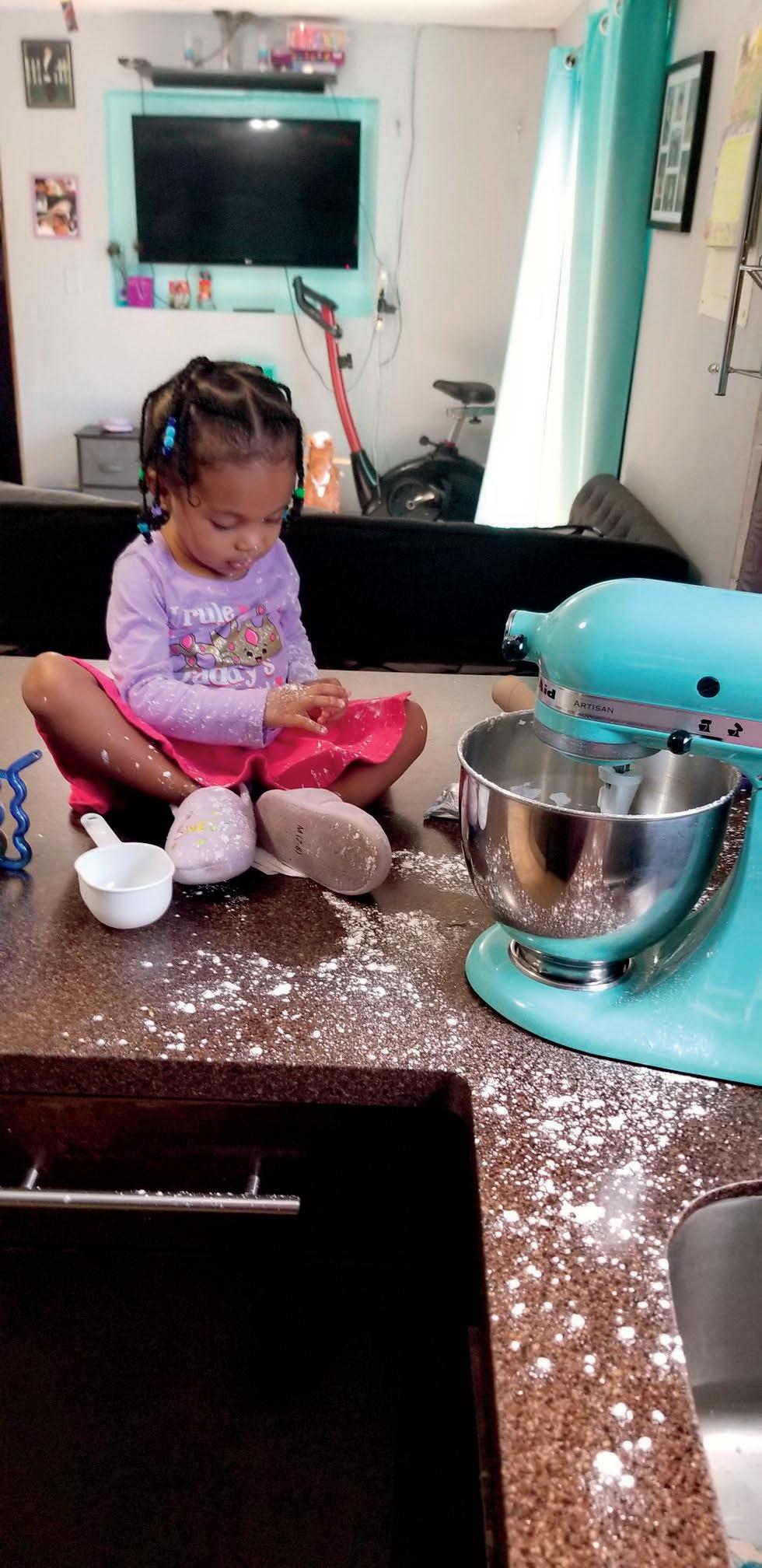




























































 By Lucie Lott
By Lucie Lott
Have you ever wondered what it would be like to see the world differently?
Those with a learning disability called dyslexia do this everyday Dyslexia affects a person’s phonological awareness, making it challenging to learn to read and write. However, people with dyslexia show above average gifts in big picture thinking, creativity, and perspective taking It is important to illuminate the need for awareness and appreciation for the unique qualities that people with dyslexia can possess.
Imagine that you are sitting in a third-grade classroom. The teacher passes out a piece of paper and tells the class that they will have a timed writing practice on the chapter they just read

For the average student, this might be nerveracking, but doable. For a student with dyslexia, however, this task feels impossible Time limits work directly against delayed memory retrieval The average student develops timed writing and memory retrieval skills naturally. The average student will go on to check off all of the boxes in the knowledge development process, such as knowledge acquisition, storage, distribution, and use (Founder, T.)
In the meantime, students with dyslexia anxiously fade into the background, slowly slipping through the cracks of this broken learning approach.
This is just one example of how a person with dyslexia may struggle in traditional settings
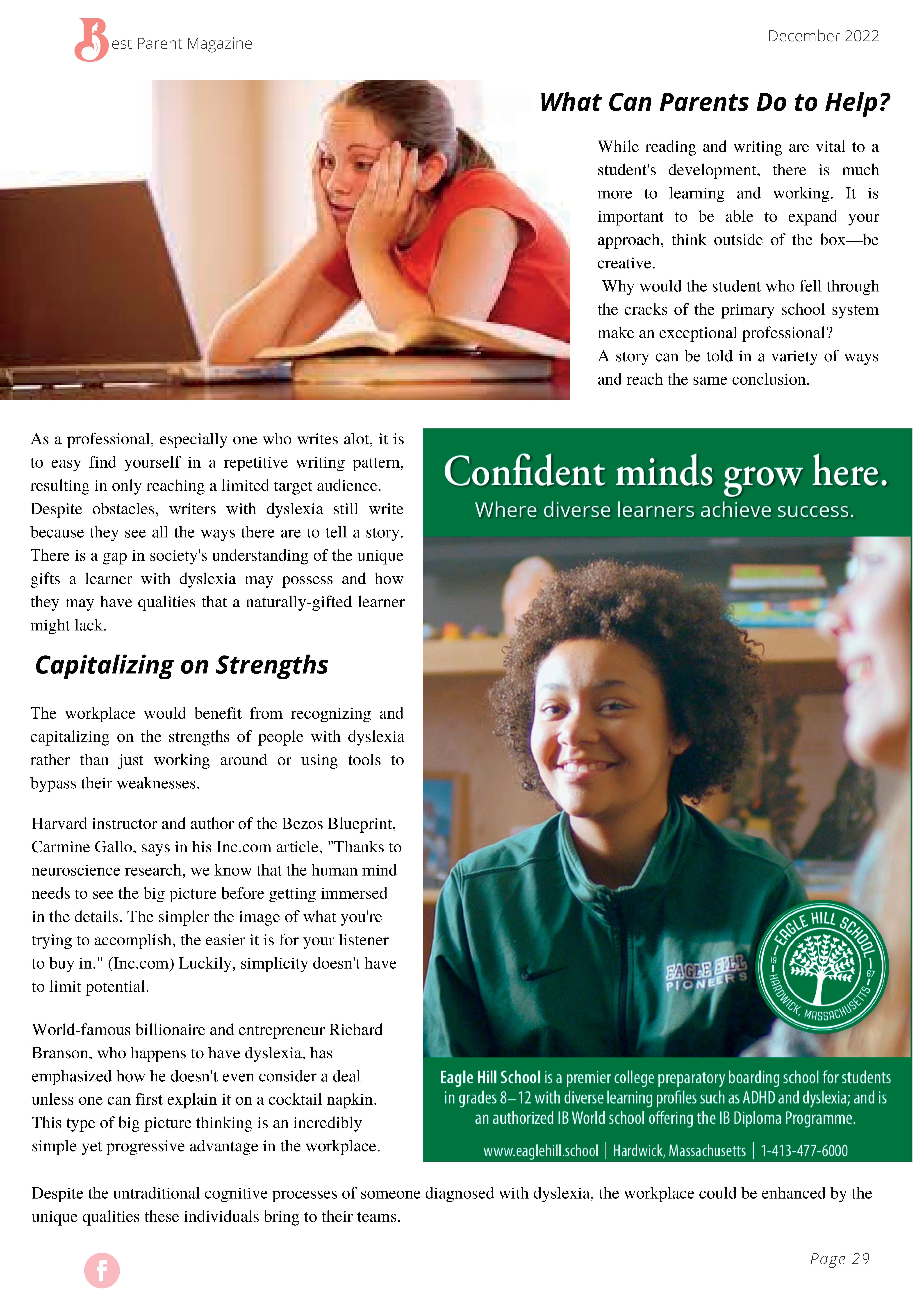






If you’re married with kids, then you're keenly aware of that all too elusive commodity – time.
Your kids are in school, their schedules are packed with extra-curricular activities and you're both working. Your own schedule is just as packed as your kids and you make it home with just enough time to do some chores, homework, and kiss the little ones to sleep before you're falling asleep.
When life gets this busy, it's tempting to put aside time with your spouse to focus on the family. But when the kids are grown and gone, you’ll realize you've neglected the core relationship of your family: your marriage
Your marriage is designed to include emotional intimacy, at every stage of life and is the core relationship to be nurtured
Prioritizing your marriage no matter the age of your children builds healthy boundaries and benefits your kids as well "It’s good modelling for the children to see what a happy marriage looks like," psychologist and author Dr. Karen Sherman explains.
The quality of the relationship between parents is a key factor associated with the cognitive, social, and emotional development of your children.
One of the best ways to keep your marriage strong is a regularly scheduled time together; but its not the only way to stay connected with your spouse.
1. Check in with your spouse
Take 5-10 minutes. First, ask what they’ve been doing that they like. Then move on to what can be improved (rather than what’s wrong) This allows each of you to stay connected, keeping lines of communication open and honest and not getting off track.
2 Dream together
Send time dating and sharing your dreams - don't spend the whole time talking about the kids. Dream together. This is one of the secrets to creating intimacy long term.
3. Find small everyday moments
Time is what matters when it comes to putting your marriage first Things you may not consider like doing the dishes together after a meal, folding laundry together, or taking a walk Be intentional, find time to chat daily; keep up on what is going on in each other’s lives. Looking for small moments can be far easier than scheduled date nights Instead of your spouse doing something alone even if it's scrolling social media together on one phone
4 Get the kids to bed
Being consistent with bedtimes allows you and your spouse time to unwind and focus on each other’s needs. It may mean putting kids to bed earlier than normal to make sure they got what they needed
5. Be sure to show love

Words are not enough Each spouse needs to show love in the manner the other person wants to receive love Words and actions will provide the nurturance you both seek and bring mutual fulfillment and satisfaction. Understanding your spouse’s love language is a great way to do this. Whether it’s words of affirmation, quality time, receiving gifts, acts of service or physical touch, Gary Chapman outlines how your spouse best receives love in his book The Five Love Languages.
6 Have fun
The two greatest gifts to give to your kids are a mom and a dad who enjoy life together and the hope of a great marriage of their own. Find what works best for both of you. The important thing is that you remember to intentionally put your marriage first





